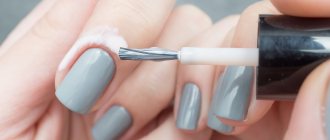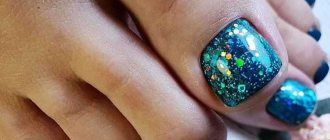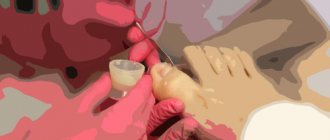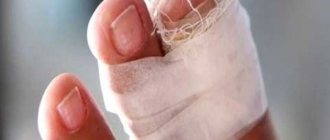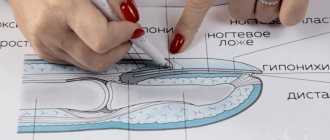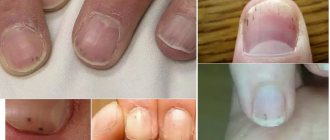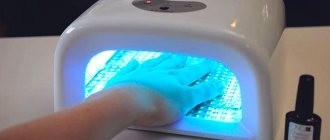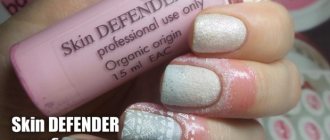Not always, when performing this or that work, we sufficiently protect ourselves.
The precautions that must be taken seem unnecessary or unnatural to us. Hardly anyone wears gloves when preparing food on a cutting board.
But it is in everyday life that we most often have the opportunity to get a splinter , sometimes without even noticing it right away.
A splinter is a painful phenomenon , especially unpleasant when it ends up under the nail, in a place where it is especially difficult to get it out.
Sometimes we do not detect a splinter immediately, but only when suppuration has already begun, since a foreign body caught under the nail most often carries an infection. It is impossible to ignore a splinter: it causes pain and can lead to serious consequences (swelling at the site of contact, suppuration, panaritium, infections, fever).
Splinters must be removed, not forgetting to thoroughly disinfect the affected area.
What types of splinters are there?
There is an opinion that skids can only be caused by wooden objects with a poorly treated surface. This is far from true. Although splinters from wooden objects are the most common, you need to be careful when working with glass, metal shavings, and plants with thorns (especially cacti).
Splinters from wooden objects
When working with gardening tools, it is necessary to protect your hands with gloves, since the cuttings of the tools are not always sufficiently well processed and covered with a protective layer.
By making sudden movements, you can bring a piece of wood under the skin or under the nail. The danger of such a splinter is that dirt gets in along with the foreign body , which without proper attention will certainly lead to decay.
| Splinters from wooden objects are dangerous because they can break when removed. Then the remaining part, sometimes not immediately noticeable, will manifest itself over time as serious complications. |
cactus splinter
Splinters from plants
Not all plants are harmless.
Even when caring for house plants, you should not forget about safety rules.
The spines or thorns may become embedded in the skin or under the nail. Remember that some plants, defending themselves in nature, not only developed “weapons”, but also supplied them with poison.
Splinters and their causes
A splinter is a foreign body that gets into the thickness of the skin, mucous membrane or under the nail plate. The penetration of a splinter into the body is always accompanied by injury to the skin, and suppuration often develops.
Any small foreign objects can become splinters:
- plant thorns;
- sharp wood chips or sawdust;
- metal shavings;
- shards of glass.
The reasons for a foreign body getting under the nail can be:
- careless handling of untreated wooden surfaces, glass fragments or metal objects;
- work in the garden or vegetable garden;
- walking barefoot.
Photo gallery: types of splinters
When caring for plants, thorns may get under the skin.
A common cause of splinters is sawdust and wood chips.
Iron filings can get under your nails or into your skin.
A glass splinter can damage not only soft tissue, but also nerve endings
Should you see a doctor if you have a splinter?
In most cases, visiting a doctor to remove a splinter from soft tissue is not required: with sufficient processing of the instruments and shallow penetration, it can be removed at home.
| The situation is different if the splinter gets under the nail. It is not easy to get to because the hard nail plate is difficult to move apart to make room for tools. |
It’s good if the edge of the splinter remains visible and does not disappear under the nail . In this case, you can grab the foreign body with tweezers and try to remove it. A splinter under the nail is very painful because the nail plate covers the nerve endings.
You should seek medical help in the following cases:
- It is not possible to remove the splinter on your own because it is deep; surgery is required , sometimes even removing part of the nail plate.
- After trying to remove the splinter on my own, part of it remained under the nail.
- It is imperative to consult a doctor if there is pulsation or visible suppuration and swelling in the affected area.
- If the splinter is from a plant whose poisonous properties you know or even suspect.
- Even if you removed the splinter yourself, but at the site of the lesion you observe a change in the color of the nail plate, deformation of the surface or other visible changes, consult a doctor immediately.
- A splinter under the nail is not only painful, but, without proper attention, can cause more serious illnesses , so seeing a doctor will help avoid unpleasant consequences.
How to avoid getting splinters
Getting such an unpleasant “surprise” as a foreign body under the nail can be completely avoided. To do this, it is recommended to adhere to the following rules:
- Follow safety precautions when working with wooden objects.
- When working in the garden or in the vegetable garden, use thick rubber gloves.
- When operating a woodworking machine or lighting a fire, protect your eyes with goggles or a mask.
- Avoid walking barefoot.
- Carry out wet cleaning more often, collect glass fragments or sawdust in a timely manner.
It is important that children do not touch thorny plants; they should not be left outside unattended. After a walk or playing in the sandbox, you should carefully check your child’s skin for damage.
Getting a splinter can not only be accompanied by pain, but also cause serious complications. To avoid them, you need to remove foreign particles in compliance with safety precautions. If attempts to remove the object yourself are unsuccessful, you should seek medical help. The main rule when removing a foreign body is to maintain sterility.
Splinter processing, splinter removal tools processing
| If the splinter has entered shallowly under the nail and part of it is accessible, then you can try to remove it yourself. |
!An important condition is the treatment of the affected area and the tools that you will use to remove the splinter.
- Before removing a splinter, be sure to wash your hands thoroughly , this is especially important if the splinter was received during gardening work or repairs, when conditions are far from sanitary.
- Treat the affected area . To do this, apply formic alcohol or a solution of boric acid (2 percent), hydrogen peroxide is also suitable. If you don’t have anything pharmaceutical with you, you can use vodka or cologne.
- Carefully treat the tools you intend to use to remove the splinter. The same products that you used to treat the wound are suitable for treatment. It is better to wipe the tools with moistened cotton pads.
- After successfully removing the splinter, it is recommended to re-treat the affected area , since the foreign object that got under the nail brought with it germs. Under the nail, where air supply is limited, they will develop quite quickly. The infection may not appear immediately and can lead to serious consequences. You can treat the area with brilliant green or iodine.
How to remove a metal splinter from your finger?
girl pulls out a splinter from under her nail with tweezers
Metal splinters come in different shapes, types and degrees of penetration. They are inconvenient because you can’t just pry them off with a needle like, for example, wooden ones.
If a thin metal splinter enters your finger parallel to the skin, then proceed as follows:
- wash your hands with soap, avoiding the affected area, and dry them
- treat the area with the splinter with alcohol, vodka or iodine
- Treat the tweezers or needle with which you will remove the foreign object with an antiseptic
- if you have a low pain threshold, wipe the area with the splinter with icecaine or any other pain reliever to which you are not allergic
- Grab the free end of the metal with tweezers and pull in the direction and at the angle where the splinter enters the skin.
- If the tip of the metal is inaccessible to grasp, use a needle to tear the skin over the splinter and use a magnet. The latter will attract the foreign body and it will come out of the tissues
However, there are cases of metal splinters penetrating deep into the tissue perpendicular to the skin. In these cases, the procedure is as follows:
- the preparation and disinfection stage is similar to the previous scheme for removing the metal body
- if the edge of the splinter is inaccessible for grasping with tongs, it should be softened with tar, potato or cabbage pulp, banana peel, vegetable oil, strong soda solution, black bread and salt
- if you see redness and pus formation around and in the wound with a splinter, go to the emergency room to see a surgeon for help
Remember that you should not press on the soft tissue around the metal splinter, as this will cause it to deepen and make it difficult to remove.
Mechanical splinter extraction technology
To remove a splinter from under your nail yourself, try the following:
- Carefully clean all necessary tools (needle, tweezers), wash your hands and treat the surface of the nail plate.
- If the splinter is small, prepare a magnifying glass.
- If the splinter is visible, the edge of the foreign body is sticking out, pick it up with tweezers and pull it at the same angle at which the splinter entered under the nail. Try not to pull with sudden movements , as you may break the splinter: in this case, it will be much more difficult to remove it.
- If the site of penetration of the splinter is difficult to see, you can smear the nail with a weak solution of potassium permanganate. A dark dot or stripe will appear at the site of penetration.
- If possible, before removing the stain from under the nail steam your finger by dipping it in warm water and soda. A slight softening of the nail will help “spread” the nail plate, which will allow the splinter to more easily come out from under the nail.
- After removing the splinter, treat the affected area. If you are in conditions that are far from sanitary, it is better to put a bandage on your finger.
How to properly disinfect a wound
After successfully removing the splinter, it is necessary to treat the inflamed area with a manganese solution, then anoint it with brilliant green or iodine solution. Vodka, cologne or alcohol will also work. Despite the preventive procedures performed, sometimes the extraction site may become inflamed.
Synthomycin liniment ointment can be applied to the inflamed area. When there is no infection in the wound, it can heal quickly. At the first signs of purulent inflammation, you should urgently see a doctor.
Folk remedies for removing splinters
To remove a splinter from under a nail, you can make compresses: 1. Add a teaspoon of vodka to a tablespoon of finely grated cabbage . Place the resulting mass in a sterile bandage and apply it to the splinter. After 2-3 hours, the splinter should pull out from under the nail. If the splinter is deep, the procedure must be repeated several times. 2. A compress of onions will help pull out the splinter , which must be grated until mushy on a fine grater. 3. An aloe leaf will help pull out the splinter. It is necessary to cut off part of the leaf, revealing its pulp. Apply the pulp to the affected area and bandage. Keep the compress for 2-3 hours . Repeat as necessary. 4. To pull out a splinter, you can apply a compress of grated potatoes.
wax will help remove the splinter
How to get it using traditional methods?
Traditional methods are also actively used to remove splinters from under the nail. Thanks to them, you can get rid of this problem at home, using products that are easy to find in everyone’s home.
Without the use of cosmetic or medical tweezers, these traditional methods exist:
- Compresses:
- Onion lotions are often used to remove splinters from under the nail plate. To do this, you need to grind the onion to a puree, apply it to the affected part of the body and wrap it tightly with a bandage. Every three hours it is necessary to change the gruel with freshly prepared one, while checking to see if the splinter has come out.
- In addition to onions, you can use a cabbage compress. To do this, the product is grated on a fine grater and mixed with a small amount of vodka.
- If you have aloe, you can use this plant to remove drifts. Place an aloe leaf on your finger, wrap it tightly with a bandage and leave for several hours.
- Grated potatoes are also actively used as a compress. The potatoes must be peeled, washed thoroughly and grated on a fine grater to obtain a paste. It must be wrapped in a bandage and applied to the affected area of the skin for several hours. Next, if it was not possible to remove the splinter, make a new compress.
- Baths. In order to get rid of a splinter, baths are perfect. Salt and baking soda must be diluted in hot water in equal proportions until a cloudy sediment appears. Next, place your hand in the bath and keep it in the liquid until it cools completely. Then the splinter is carefully removed from the affected area of the skin.
- White clay. This product also helps get rid of splinters trapped under the nail plate. For this recipe, you need to dilute the white clay powder with water and generously grease your finger with the resulting paste. Next, the finger is fixed with a bandage and left for several hours.
- Laundry soap. When a splinter gets under the nail, people often resort to using this product.
The soap is rubbed on a fine grater, mixed with a small amount of water and the resulting slurry is applied to the damaged finger, securing it with a bandage. Laundry soap can be added to hot water and used as a bath. - Resin or wax. The heated product is applied to the affected area of the skin with a splinter and left until it cools completely. The product adheres to the foreign body under the nail plate, after which the splinter is easily removed from the skin.
Thanks to this stage, the foreign body will more easily and painlessly come out from under the nail plate. All products and materials used must be as sterile and disinfected as possible to avoid the possibility of infections and purulent inflammations.
After removing a splinter from under the nail plate, the following recommendations must be followed:
- regularly treat your finger with a disinfectant;
- keep your hands clean until the wound is completely healed;
- Pay attention to comprehensive hand care.
If you are unable to remove the splinter on your own, be sure to consult a doctor, as even a small foreign object under the nail plate can lead to significant complications. We hope the article was useful to you and you were able to find the answer to your question!
Wax and resin for removing splinters from under the nail
If the tip of the splinter is slightly visible, but it is impossible to pry it off, it is recommended to use resin or wax .
- Apply heated wax or resin to the nail and leave until completely hardened.
- Afterwards, carefully remove the wax or resin in the direction of the splinter’s entrance.
- The splinter should attach to the wax or resin and come out when it is removed.
- You can soak your finger in a bath of soap or soda before applying wax or resin: this will soften the nail.
How to remove an old splinter?
an old splinter removed with tweezers
Not all people are able to immediately feel a splinter after its insertion. This is due to a high pain threshold or, for example, concentration on the work at hand.
But while taking a shower before bed, all wounds and splinters become obvious due to pain and discomfort. The latter already manage to acquire pus and inflammation of the skin around them.
This is where the question of removing a foreign body arises. To do this with minimal pain and health risks, do the following:
- assess the condition of the wound, the depth of penetration of the splinter, the degree of inflammation and your strength to remove the foreign body
- prepare your tools, disinfect them and the surface of the affected area if you decide to remove the splinter yourself
- lubricate the wound with alcohol or hydrogen peroxide and go to the emergency room to see a surgeon for professional help if you see that you cannot cope with the task alone
Remember, the longer a splinter remains in the soft tissue, the more inflammation it causes and the more difficult it is for the doctor to remove it without harming the integrity of your body.
Complications after removing a splinter from under the nail
A splinter caught under a nail is dangerous due to its complications.
It is not always possible to remove it completely the first time. Even a small fragment left under the nail can lead to decay.
After removing the splinter, it is important to carefully treat the affected area and monitor the condition for several days . If you feel throbbing or pain, be sure to consult a doctor , as these are the first symptoms of possible complications. Penetrating under the nail, the splinter brings with it an infection that quickly spreads. If you notice swelling or redness, contact your doctor. Sometimes delay leads to the need for surgical intervention, including removal of the nail plate.
Symptoms accompanying a splinter
A foreign object can penetrate into the thickness of soft tissue to different depths. The main symptoms of a splinter are:
- violation of skin integrity;
- pain at the site of penetration of a foreign object, which intensifies with pressure;
- a piece of splinter protruding above the surface of the body;
- transillumination of a foreign body through the nail plate.
If a foreign body completely penetrates the surface layers of the skin, it can be seen with the naked eye. Sometimes the embedded particles are so small that they do not immediately cause discomfort and remain invisible. However, this is precisely their danger.
The most painful are splinters that get caught under the nail plate.
Splinters under the nails are the most painful and difficult to remove.
Any foreign body that gets under the nail carries pathogens and can cause infection. If it is not removed immediately, there is a high risk of developing an inflammatory process. Signs of inflammation are:
- redness of the skin in the affected area;
- swelling of soft tissues;
- severe pain;
- limited mobility due to pain and swelling.
The soft tissue around the splinter becomes inflamed and suppurates.
Over time, an abscess forms, surrounded by a dense capsule. Acute purulent inflammation of the fingers or toes is called felon. Nail whitlow is called paronychia (paronychia). Getting a splinter under the nail plate is very dangerous and is accompanied by severe pain. In addition, the fingertips and areas of the nail plates have a good blood supply, which contributes to the rapid spread of the purulent-inflammatory process.
If an infection occurs when a splinter gets under the nail, a purulent complication may develop - paronychia.
The author of the article encountered a similar problem several times. In the summer, while walking in open shoes, a microscopic thorn got under my nail. She didn’t show herself right away. After 3 days, the nail fold of the big toe began to turn red and swell. Pus began to accumulate under the nail and ooze from under the plate. I had to see a surgeon. Under local anesthesia, part of the nail was cut off, pus and a foreign body (most likely a thorn from some plant) were removed. For the first 2 days, the wound on my leg hurt and bled heavily, and it became necessary to take painkillers. For several days I had to limit my movements and sit with my leg elevated.
It can be especially difficult to remove such a foreign body, so splinters under the nails often require a visit to the doctor.
What happens if you don't touch the splinter
The consequences are unpleasant and sometimes dangerous to health. With a splinter, an infection always gets under the skin, which spreads throughout all living tissues.
Complications
So, what happens if you don’t get the splinter:
- the damaged area swells and turns red;
- the splinter breaks out, inflammation develops and pus collects under the skin;
- my finger hurts.
Such symptoms always appear when a foreign body is not removed in a timely manner.
If the splinter festers, then the wound is infected. Symptoms of infection may not appear immediately. Sometimes pain appears only on the third day, and then the finger breaks out.
Important. If the splinter is not in the finger, but in the foot, then when walking the foreign body is driven deep into the skin. As a result, the wound does not heal, and the area of suppuration becomes larger.
In the photo you can see the consequences of the splinter.
If the splinter is deep and the inflammatory process has already begun, it is removed surgically. A small incision is made on the finger to remove the foreign body, disinfect and treat the wound.
Possible threats
The consequences of a splinter are quite dangerous:
- blood poisoning;
- gangrene;
- tetanus infection.
What is dangerous about a splinter is that it can even lead to death if a person is not provided with medical assistance in a timely manner.
In any case, a foreign body is a source of infection. If it remains under the skin for a long time, then the bacteria cause not only suppuration and inflammation, but also blood poisoning. There is a need to fight for human life.
Even more dangerous than wood, metal and glass splinters. A glass shard can damage not only soft tissue, but also nerve endings. The pain in this case is unbearable. It is not advisable to take it out yourself, since with one wrong movement you can crumble a foreign body. You'll have to go to a surgeon and cut your finger.
The consequences of a metal splinter in a finger are similar to a wooden foreign body. This is suppuration and infection. Since metal rusts quickly, inflammation from a splinter develops faster. The inflammatory process spreads to the entire finger, and the infection enters the bloodstream much faster. A metal splinter can also become overgrown with skin and remain in the finger forever.
The video in this article talks in more detail about all the consequences of a splinter.
What to do with deep and old splinters?
A deep splinter causes more trouble than a foreign object located close to the skin. The danger lies in infection of the tissue, and then the entire body, by microbes that could be on a foreign object.
Penetrating to great depths, the splinter damages soft tissues and blood vessels of the finger, which, in turn, can lead to blood poisoning and the development of ulcers in the damaged area. A foreign body located next to the skin is much safer because it damages only the layers of the skin, and not the subcutaneous layer, blood vessels and nerves.
It doesn’t matter whether the splinter is deep or not, its appearance requires immediate removal so that the consequences later are not dire. In any case, if it is not possible to remove the foreign object yourself, or you simply cannot do it, you should immediately contact a highly qualified specialist.
At home, to remove a splinter that is located deep, it is enough to make baths. You can take any oil (vegetable, olive), heat it slightly and dip your finger in it. Such a bath will allow the splinter to come out a little from under the nail, so that later you can remove it with tweezers, a needle or other sterile instrument.
You can take alcohol (boric acid, pure alcohol) or vodka, pour it into a cup and dip your finger in there for half an hour. The organic compound will allow the splinter to “look out” for further removal.
To completely dissolve the splinter, you can use ammonia. Take this organic compound and pour it into a bowl, then put your finger in there for 2-3 minutes. After the time has passed, it is pulled out and wrapped in a warm thing (towel, handkerchief, etc.).
An old splinter, which you may not have noticed or did not pull out in time, is removed so that inflammation does not develop later. You can pull it out with a scalpel or tweezers, which are pre-boiled and disinfected with the means mentioned earlier.
If it is impossible to remove the splinter on their own, they resort to the help of a doctor, but the surface with the foreign object must be lubricated with an antiseptic (hydrogen peroxide, alcohol, etc.) before going to a specialist.
There is a deep splinter under the nail, what should I do?
disinfection of the finger and nail plate with a splinter before removing it
The deep location of the splinter makes it difficult to quickly remove. Therefore, measures to push the foreign body to the exit cannot be avoided.
First, soberly assess your ability to remove such a splinter. If there is even the slightest doubt, go to the doctor for help.
If you decide to get it yourself, then use folk remedies to soften the tissue. They will be discussed in detail in the next subsection.
Removing a splinter from a child
The problem of splinters in young children is much greater than in adults. Solving it is complicated by the fact that children cannot show the exact location of the injury, do not tolerate pain well and cannot stand the sight of a needle, which parents traditionally take to remove a foreign body. Therefore, if you suspect that your baby has received a splinter, you need to remember the following recommendations:
- The first thing you need to do is calm the little patient down and distract him with toys. Otherwise, the child will not allow you to touch the sore spot and may drive the splinter even deeper.
- Methods without a needle are better for children. This is extraction with glue, adhesive tape, or “Ichthyol ointment.”
- The child can be offered a “water game” by adding baby soap to a bowl of warm water. The skin of the injured area will soften, and the tip of the splinter will appear above the surface.
The most important thing in helping a child is the peace of mind of the parents.
If you are not confident in your abilities or the splinter has entered deeply into the tissue, it is better to go to the emergency room, where your baby will quickly receive professional help.

